| A | B |
|---|
| What are the four phases of the cell cycle? | G1, S, G2, and M p231,  |
| Chromosomes are only visible (with a light microscope) when ___. | the cell is dividing (After cell division in the G1 phase, the chromosomes are in the form of a single, long thin chromatin fiber. After DNA replication in the S phase, the chromatin fibers are attached forming two attached sister chromatids, and these start to condense by coiling more tightly, but are not visible with a light microscope until they have completely condensed into discreet visible chromosomes, still referred to as sister chromatids until they have separated into individual chromosomes at the start of anaphase) pp.229&232 |
| When DNA is replicating, the cell is in the ___ phase of interphase. | S p231,  |
| Name the three major phases of interphase in the order that they occur. | G1, S, and G2 (Non-dividing cells, such as most nerve cells, spend their time in a phase of interphase called G0, "G-zero") p231,  |
| When the cell is undergoing cell division, it is in the ___ phase. | M (The mitotic (M) phase of the cell cycle includes mitosis and cytokinesis),  |
| In order, what are the five stages of mitosis? | Prophase, prometaphase, metaphase, anaphase, telophase (remember "I pinched pretty Martha's arm today" for interphase, prophase, prometaphase, metaphase, anaphase, and telophase. Interphase is NOT a stage of mitosis, but it does come before mitosis) pp231-233,  |
| G1, S, and G2 all occur during ____. | interphase p231,  |
| Cell division ends when ___ is complete. | cytokinesis p230,  |
| The ____ is a series of events that a cell goes through from the time it is first formed from a dividing parent cell until its own division into two daughter cells. | cell cycle p228,  |
| The ___ is a region of a each sister chromatid in a duplicated chromosome containing specific DNA sequences where the chromatid is attached most closely to its sister chromatid. Proteins associated with this region give the condensed, duplicated chromosome a narrow waist. | centromere (The centromere is a region of a each sister chromatid in a duplicated chromosome containing specific DNA sequences where the chromatid is attached most closely to its sister chromatid. Proteins associated with this region give the condensed, duplicated chromosome a narrow waist) p229&230,  |
| The centromere is a region on a chromosome where ______ are held together most closely. | sister chromatids pp229&230,  |
| After chromosomes undergo DNA replication, they consist of two identical ____ that are attached to each other along their length by proteins called cohesins (most closely in a region called the centromere). | sister chromatids pp229&230,  |
| During which stages of mitosis are sister chromatids attached to each other? | prophase, prometaphase and metaphase p232,  |
| During which stage of mitosis do sister chromatids start to separate? | anaphase p233,  |
| During which stage of mitosis are sister chromatids lined up along the center of the cell? | metaphase (think metaphase = middle) p233,  |
| During which stage of mitosis do the chromosomes condense to become visible? | prophase p232,  |
| In animal cells, ________ are found in the centrosome, but don't seem to affect the ability of the cell to undergo mitosis. | centrioles p231,  , , 
|
| The division of the cytoplasm itself is called ___. | cytokinesis p230,  |
| In plant cells, cytokinesis is accomplished with the formation of a(n) ___ between the two new daughter cells. | cell plate (The cell plate will continue to fill in forming a cell wall between the two new daughter cells) pp235&236,  |
| During which stage of mitosis are the chromosomes divided into the two opposite ends of the cell with the nuclear membrane starting to reform? | telophase p233,  |
| The two main stages of cell division are ___. | mitosis and cytokinesis (Cell division is considered to be the mitotic (M) phase of the cell cycle. Interphase is the phase of the cell cycle in-between cell division) p231,  , , 
|
| One main difference between cytokinesis in plants versus animals is that plant cells form a(n) ___ to divide the cytoplasm while animal cells form a(n) ______ to divide the cytoplasm. | cell plate, cleavage furrow,  |
| During which stage of mitosis does the nucleolus disappear? | prophase p232,  |
| During normal cell division, a human cell with 46 chromosomes would produce two daughter cells with ___ chromosomes each. | 46 p230 |
Which stage of mitosis is depicted in the picture below?, 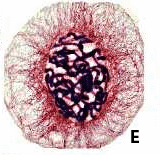 | Prophase p232,  |
Which stage of mitosis is depicted in the picture below?, 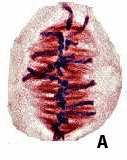 | Metaphase p233,  |
Which stage of mitosis is depicted in the picture below?, 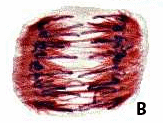 | Anaphase p233,  |
Which stage of mitosis is depicted in the picture below?, 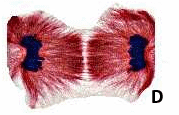 | Telophase p233,  |
Which stage of the cell cycle is depicted in the picture below?, 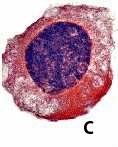 | Interphase p232,  |
The structures labeled A are,  | sister chromatids (This diagram shows sister chromatids joined only at the centromere, not by cohesin proteins all along the length of the chromatids. Evidently, some species do not have their sister chromatids joined at all points like humans do. See the description of prophase on page 232) p.231,  |
The structures labeled B are,  | kinetochore microtubules (A type of spindle fiber. This diagram shows sister chromatids joined only at the centromere, not by cohesin proteins all along the length of the chromatids. Evidently, some species do not have their sister chromatids joined at all points like humans do. See the description of prophase on page 232) pp231&235, 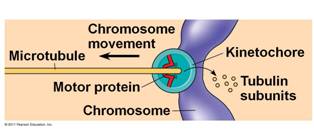 |
The structure labeled C is,  | a centromere (This diagram shows sister chromatids joined only at the centromere, not by cohesin proteins all along the length of the chromatids. Evidently, some species do not have their sister chromatids joined at all points like humans do. See the description of prophase on page 232) p.231,  |
The plant cell labeled A is in the ____ phase of mitosis.,  | anaphase p236,  |
The plant cell labeled B is in ____.,  | telophase p236,  |
The plant cell labeled C is in ____.,  | interphase p236,  |
The plant cell labeled D is in ____.,  | prophase p236,  |
The plant cell labeled E is in ____.,  | metaphase p236,  |
| Cells that divide excessively and invade other tissues are referred to as ____ cells. | cancer p242 |
| When cells divide over and over again because of cancer, a lump of cells called a(n) ____ forms. | tumor p242 |
| A(n) ____ can cause the proteins that control cell division to malfunction, causing the cell to divide uncontrollably. | mutation in DNA p242 |
| Who said "Every cell from a cell." | Rudolph Virchow (A German physician who said this in 1855, meaning, every cell comes from a pre-existing cell) p228 |
| Cell division results in genetically identical ______ cells. | daughter p228 |
| Cell division results in genetically _______ daughter cells. | identical (Although the cells are genetically identical, meaning that they contain the same DNA, they are not always physically identical. Cells differentiate as they divide, expressing different genes and developing differently. If they didn't, organisms would be a lump cells, each identical to the original fertilized zygote cell.) p228 |
| All of the genetic information a cell possesses is called the cell's ______. | genome p229 |
| All body cells except reproductive cells are called ____ cells. | somatic p229 |
| Another word for reproductive, or sex cells is ________. | gametes p229 |
| How many molecules of DNA are contained in one chromosome? | one (It's very long. If stretched out, the DNA molecule in a typical human chromosome is about 4 cm long. All of the DNA in a typical human cell could stretch to about 2 meters) p229 |
| The type of cell division that produces sex cells (eggs and sperm) is called ______. | meiosis p229, 
|
| In humans (and many animals for that matter), the two types of gonads are ______ and _____. | ovaries and testes (This is where meiosis occurs to produce eggs and sperm) p230 |
| Another word to describe both the ovaries and testes is ______. | gonad p230 |
| What do the asters attach to by the time the cell is in metaphase? | the plasma membrane p234,  |
| Non-kinetochore microtubules are responsible for _____ the cell during anaphase. | elongating p234,  |
| What causes the cleavage furrow in animal cells? | Actin microfilaments contracting with myosin (the same proteins responsible for muscle contraction) p234,  |
| Prokaryotes reproduce by a type of cell division called ____. | binary fission (This term also applies to single-celled eukaryotic organisms like an amoeba, but binary fission in eukaryotic single-celled organisms involves mitosis while prokaryotic organisms to not use the steps of mitosis to divide their genetic material. The term binary fission simply means "division in half.") p236,  |
| Name two types of human cells that never divide once fully mature. | nerve and muscle cells (Both enter G zero once fully formed; a phase that takes cells out of the cell cycle. It was once thought that human brain cells never divide, but recent studies show that humans have some undifferentiated neural stem cells in certain regions of the brain that continue to divide in a very limited fashion) p238 |
| In mammalian cells, the most important checkpoint for regulating the cell cycle, commonly called the restriction point, is found in the ____ stage of interphase and is called the _____. | G1, G1 checkpoint p239,  |
| What are the two main types of regulatory proteins that work to regulate the cell cycle? | kinases and cyclins (cyclins are proteins that have levels that fluctuate. They activate a type of protein kinase called "cyclin-dependent kinases," or "Cdks." Remember from chapter 11 that protein kinases are enzymes that activate or inactivate other proteins by phosphorylizing them. These are important in signal transduction pathways, including the ones that regulate the cell cycle.) p239 |
| A(n) _____ is a protein that gets its name from its cyclically fluctuating concentration in cells. | cyclin (The graph below shows how cyclin concentration regulates a cyclin-dependent regulatory protein that is needed to trigger the cell to enter the M phase of the cell cycle) p239,  |
| Kinases that regulate the cell cycle are activated by attaching to cyclins, and are therefore called _____. | cyclin-dependent kinases OR Cdks (The graph below shows how cyclin concentration regulates a cyclin-dependent regulatory protein that is needed to trigger the cell to enter the M phase of the cell cycle) p239,  |
| A(n) _______ is a protein released by certain cells that stimulates other cells to divide. | growth factor p240 |
| Density-dependent inhibition is a phenomenon in which _____ cells stop dividing. | crowded (* Cancer cells don't seem to exhibit density-dependent inhibition) p241,  |
| Cells cultured on a petri dish will divide until they form a single layer that covers the bottom of the petri dish. If some cells are removed, the remaining cells will start dividing again until the bottom of the petri dish is covered again. These observations are strong evidence that cell division is at least partly controlled by _____ signals. | external signals (the cells must be responding to signals in their external environment to realize that they are crowded, and therefore stop dividing. Unfortunately, cancer cells don't do this.) pp240 and 241,  |
| In order to divide, most cells (excluding cancer cells) must be attached to a substrate, such as the inside of a culture dish, or the extracellular matrix of a tissue. This phenomenon is called ______. | anchorage dependency p241 |
| Which type of cells do not seem to be affected by density-dependent inhibition or anchorage dependency? | cancer cells p242 |
| A tumor that stays at its original site of growth is called a(n) _____ tumor. | benign p242 |
| A tumor that is impacting other organs or tissues (is invasive) and is capable of spreading is called a(n) ______ tumor. | malignant (Individuals with malignant tumors are said to have cancer) p242 |
| The spread of cancer cells to locations distant from their original site of development is called _____. | metastasis,  |
| A benign tumor is usually treated by surgery to remove it or by _____. | radiation (radiation seems to mutate cancer cell DNA much more than normal cell DNA because cancer cells seem to have lost the ability to repair mutations. Mutated cells usually stop functioning, just as a grandfather clock usually stops functioning if you throw a monkey wrench into it) p243 |
| Malignant tumors are usually treated by ______. | chemotherapy (Chemotherapy involves the administration of drugs that interfere with the cells ability to divide. Unfortunately, these drugs tend to affect normal cells as well, so that hair can't be replaced, nor the cells on the inside of the intestine, leading to nausea and hair loss) p243 |
The diagram below depicts a cell in ______.,  | anaphase p233,  |
The process shown below is a special type of cell division called ______ that occurs in _______.,  | binary fission, prokaryotes (This term also applies to single-celled eukaryotic organisms like an amoeba, but binary fission in eukaryotic single-celled organisms involves mitosis while prokaryotic organisms to not use the steps of mitosis to divide their genetic material. The term binary fission simply means "division in half.") p237,  |
The picture below shows the formation of a _____ in a _____ cell.,  | cell plate, plant cell p235,  |
The picture below shows the formation of a(n) _____ in a(n) _____ cell., 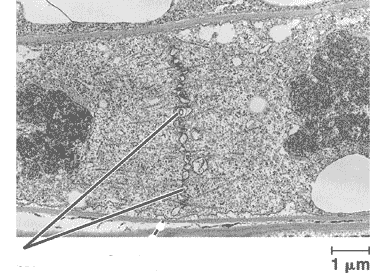 | cell plate, plant cell p235,  |
The red arrows are pointing to a(n) _____ in a(n) ____ cell.,  | cleavage furrow, animal cell p235,  |
The line is pointing to a(n) _____ in a(n) ____ cell., 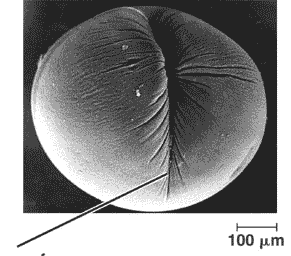 | cleavage furrow, animal cell p235,  |
The diagram below depicts a cell in ______.,  | interphase p232,  |
The letter "A" in the picture below is pointing to _____.,  | two sister chromatids p234,  |
The letter "B" in the picture below is pointing to _____.,  | the aster p234,  |
The letter "C" in the picture below is pointing to _____.,  | the centrosome p234,  |
The letter "D" in the picture below is pointing to _____.,  | metaphase plate p234,  |
The letter "E" in the picture below is pointing to _____.,  | the kinetochores p234,  |
The letter "F" in the picture below is pointing to _____.,  | the kinetochore microtubules (a type of spindle fiber) p234,  |
The letter "G" in the picture below is pointing to _____.,  | the overlapping non-kinetochore microtubules (a type of spindle fiber; they are used to lengthen the cell during anaphase. These are sometimes called "polar" microtubules) p234,  |
The diagram below depicts a cell in ______.,  | metaphase p233,  |
The dotted line shows an imaginary plane midway between the two centrosomes called the _____.,  | metaphase plate p233,  |
The diagram below depicts a cell in ______.,  | prophase p232,  |
The diagram below depicts a cell in ______.,  | prometaphase p232,  |
The diagram below depicts a cell in ______.,  | telophase p233,  |
| What are the two types of spindle fibers? | kinetochore microtubules ("F" in the picture below; they attach to kinetochores on the sister chromatids) and non-kinetochore microtubules ("G" in the picture below; used to elongate the cell during anaphase) pp231&234,  |
What is "D" in the picture below pointing to?,  | kinetochores (a protein structure on the outside of the sister chromatids that serves as a place of attachment for the spindle fibers "kinetochore microtubules") p234,  |
| How many chromosomes can be found in the typical human cell? | 46 p229 |
| How many PAIRS of chromosomes can be found in the typical human cell? | 23 pairs (One of each of the paired chromosomes comes from the person's father while the other comes from the mother) p229 |
| How many chromosomes can be found in the typical human reproductive cell? | 23 p229 |
| How many PAIRS of chromosomes can be found in the typical human reproductive cell? | zero (after going through meiosis, the newly formed gamete only has 1 of each pair of chromosomes, not both) p229 |
Initially, sister chromatids (like the ones pictured below) are attached all along their lengths by protein complexes called ______. This attachment is known as _________. The sister chromatids are attached most closely at the region of the ______.,  | cohesins, sister chromatid cohesion, centromere p229&230,  |
| Why does the nucleolus disappear during mitosis? | Because Chuck Norris wants it that way. If you ask him why, you are likely to disappear too (If you really want to know, you can read this research paper at http://www.springerlink.com/content/kjq82434unh3580r/ . Just don't let Chuck catch you!!, 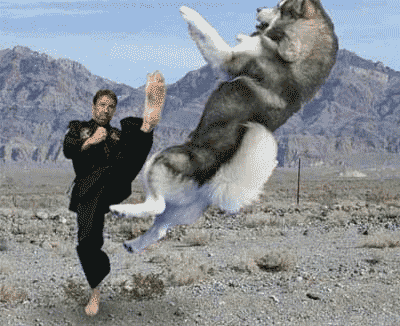 |
| The mitotic spindle includes the _______, ________, and _______. | centrosome, spindle microtubules, asters pp231&234,  |
| ___ is the process that converts a normal animal cell into a cancerous cell. | Transformation (The term "transformation" is also used to describe the process where a cell takes in external DNA and incorporates it into its own genome. We will learn more about this type of transformation later in the genetics unit) p242 |
| Another name for the G1 checkpoint is the _____. | restriction point (This seems to be the most important checkpoint for most mammalian cells) p239,  |
| A(n) _____ is a point in the cell cycle where molecular "stop" and "go ahead" signals regulate whether or not the cell continues the cell cycle. | checkpoint p239,  |
| Which cyclin-dependent kinase needs to be activated in order for cells to enter the M-phase of the cell cycle? | MPF (The initials stand for "maturation-promoting factor" but it is more helpful to remember it as "M-phase-promoting factor" in order to remember what it does) p239,  |
| What are the names of the three checkpoints in the cell cycle (Hint: They correspond to the phase of the cell cycle in which they are found)? | G1, M, G2,  |
| What does the root word "chromo-" mean? | color (chromatin is named because of its ability to be color stained with dyes) |
| What does the root word "cyclo-" mean? | circle (cyclin is a regulatory protein whose concentration fluctuates in a cycle) |
| What does the root word "mal-" mean? | bad (A malignant tumor is a bad kind to get) |